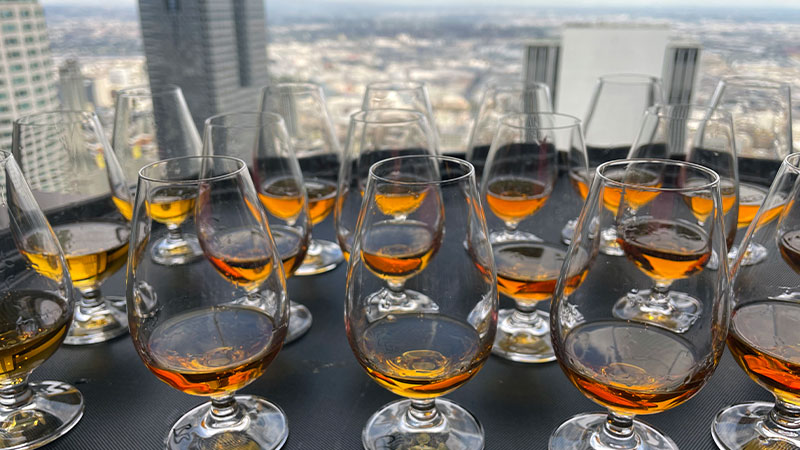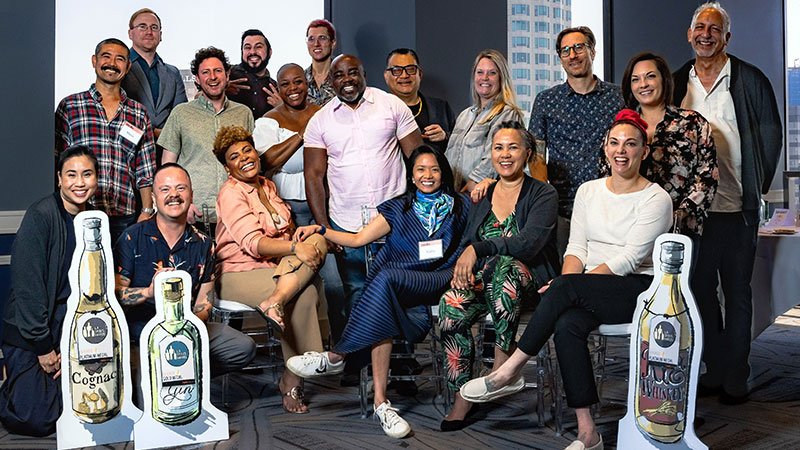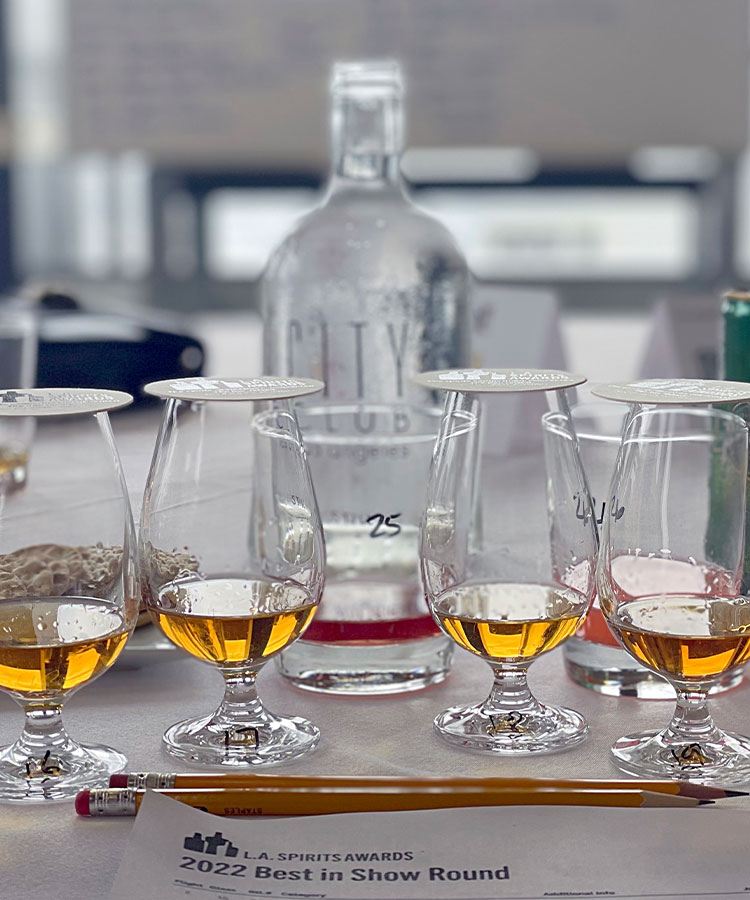
Regardless of your knowledge of spirits, enter a liquor store and there are two tangible factors that can immediately sway your purchasing decision: the price of a bottle, and the possible appearance of a small sticker or tag bearing a medal. Affordability is, of course, always subjective, but we’re all familiar with our financial limits. And I’d wager that as far back as elementary school — long before most of us witnessed our first Olympic Games — we each gained an understanding of the relative merits of bronze, silver, and gold.
In the spirits realm, such signifiers are a useful tool for snagging the all-important bang for your buck. Pick up a bottle that boasts gold at a price you hoped to spend, and you can walk out of that store feeling pretty darn confident in your decision — irrespective of whether you’re versed in the differences between highland and lowland tequila or Islay and Speyside Scotch.
How did that medal get there, though? And what exactly does gold represent?
I’d bet a similar sum to my elementary stake that many among us have little or no idea — not just newcomers to the drinks space but industry professionals at large, and even the very folks who produce the wonderful spirits that adorn liquor shelves.
As a returning judge for the 2022 L.A. Spirits Awards — one who’s very excited to share this year’s Best in Show winners today — allow me to take you behind the scenes. Because just as there isn’t a bottle label large enough to capture the full labor and love that goes into every spirit, the story of each awarded medal delves much deeper than their seemingly simple significance belies.
The Judging Process 101

This is the third year VinePair has partnered with the L.A. Spirits Awards to share the Best in Show winners. Previous iterations of this literature have explored in great detail many aspects of the judging process, as does the awards’ website. But I’ll save you the pleasure of opening a 15th Google tab for now with a quick primer: Over the course of two days, each of the L.A. Spirits Awards’ 16 judges tastes hundreds of spirits. The first round of tasting identifies initial medals, while two subsequent rounds confirm the revered platinum medals, and see the most impressive samples pitted against each other in a bracket-style contest to finalize the Best in Show bottles.
In order to combat palate fatigue — the age-old enemy of spirits judging — each judge does not sample every entry. Instead, the group first peels off into predetermined smaller panels (ideally comprising an odd number of judges), to taste through a progression of flights.
During the tasting of a flight, which will typically comprise six to 10 samples, spirits are not judged against one another but relative to their greater categories. They are, however, grouped so that gins are tasted alongside other gins and mezcals are not matched with aged whiskeys. Take it from me: It’s not fair on anyone if a judge is tasked with appreciating the subtle nuances of a vegetable-based vodka immediately after washing a heavily peated single malt over their palate. Flights evolve as a carefully calculated progression, from lower proof and neutral flavored to whiskeys those “in the know” might describe as “smoke bomb” Scotches or “hazmat” bourbons.
After each judge individually completes their flight and settles on provisional scores — gold, silver, bronze, or no medal — results are shared among the panel in front of an independent group leader. In reality, judges usually arrive at verdicts that include a “plus” or “minus,” and discussions between the group then help reach unanimity. “I marked this gin a bronze plus,” one might say to two fellow tasters, “but I’m happy to push it to a silver if that’s how you both feel.”
When judges are less willing to budge on their initial score, the importance of having an odd number in each panel comes into play, as there will always be either a majority or a clear middle ground. One vote each for bronze, silver, and gold? That’s a pretty safe silver. Only in the case of three gold medals will a spirit ever be awarded platinum and possibly then considered for the “Best In Show” tasting, which is conducted by, and takes into account the opinion of, every single judge.
For this grand finale, votes are cast by a simple raising of the hand and confirmed by multiple counters. You might reasonably think that judges are, at this point and in the presence of a larger group of individuals, less likely to have complete conviction in their opinions. On the contrary, this moment presents some of the event’s most impassioned debates — all in the name of identifying and highlighting the best of the best.
The Importance of Diversity

Scanning the room during this year’s in-person tasting, it was quickly apparent that L.A. Spirits Awards judges are a diverse group. This is by design, and one of the primary driving factors for founders Nicolette Teo and Joel Blum. Having a diverse makeup of professionals in that room and judging each spirit best represents the myriad identities that walk into a liquor store or browse a brand’s website on any given day.
Looking around my table and at my panel, I may not only be met by welcoming faces from different cultural backgrounds but professional ones, too. This is similarly important, especially when discussions begin.
A fellow judge who may happen to be a very accomplished bartender likely factors into their score how the spirit in front of them would perform in cocktails. As a spirits writer and reviewer who tastes hundreds of bottles from each category every year, I may be quicker to consider the sample’s merit compared to the standard or norm in its particular field. When talks commence, we share our opinions and experiences and ultimately land upon a reasoned, water-tight verdict.
Pouring Volunteers: the Unsung Heroes
Ensuring that flights arrive at each panel’s table at exactly the right moment are the awards’ unsung heroes — volunteers who pour each sample into glasses identical in every aspect other than small identifiable numbers, and who act as an impartiality-ensuring barrier between directors and judges. All of the pouring takes place in a separate room, one which a judge will never enter until all final votes are cast and medals are awarded.
These volunteers also help my colleagues and me fight that greatest of enemies of the spirits judge: palate fatigue. They keep us topped up with a healthy supply of water — still or sparkling, just as in any of the storied restaurants of the City of Angels — and a never-empty plate of crackers and mild cheeses.
If not before now, then at this point you are surely wondering the single most common question I receive when describing the nature of this work to those unfamiliar with the process: If we’re tasting dozens of high-proof spirits before we even break for lunch, how are we not on the floor by 11 a.m.? The answer: We sniff, we sip, we spit, and then we repeat. Should we require a top-up, our helpful volunteers are always on hand to provide a swift sample — poured in that separate room, of course.
The L.A. Spirits Awards judging process is, as I hope it’s abundantly clear by this point, a well-oiled machine dependent on multiple, equally important cogs. The very nature of ensuring impartiality, and absolute separation of church and state, requires it to be just so.
The next time you walk into your favorite spirits retailer and encounter a bottle with a medal, think of that iceberg that’s commonly portrayed in motivational memes on professional social networking sites. Each medal awarded represents only the tip of the iceberg, while the process for getting there is the vast mass lurking below the surface unseen.
Without further ado, here are the Best in Show winners of the 2022 L.A. Spirits Awards.
Best in Show — L.A. Spirits Awards 2022
Best Vodka
Trader Joe’s Texas Vodka – Houston, USA
Best Flavored Vodka
Mushroom Spirits Distillery Hen of the Woods Flavored Vodka – New York, USA
Best Aquavit
Batch 22 Classic Gold New American Aquavit – California, USA
Best Gin
Papa Salt Coastal Gin – New South Wales, Australia
Best Rum
Ten To One Caribbean White Rum – Jamaica and Dominican Republic
Best Cachaça
Ajornada Carvalho Cachaça – Brazil
Best Tequila & Best Blanco Tequila
Don Vicente Blanco Tequila – Jalisco, Mexico
Best Añejo Tequila
Cutwater Spirits Añejo Tequila – Jalisco, Mexico
Best Extra Añejo Tequila
Jose Cuervo Reserva de la Familia Extra Añejo Tequila – La Rojeña, Mexico
Best Mezcal
Victorioso Artisanal Mezcal Tobalá – Santiago Matatlán, Oaxaca, Mexico
Best Bourbon & Best Straight Bourbon
Legent Kentucky Straight Bourbon – Kentucky, USA
Best Unique Barrel-Finished Bourbon
Barrell Armida Bourbon – Kentucky, USA
Best Tennessee Whiskey
Uncle Nearest Master Blend Edition Whiskey, Batch 009 – Tennessee, USA
Best Whisky & Best American Single Malt Whisky
Virginia Distillery Company Courage & Conviction Cuvée Single Cask American Single Malt Whisky – Virginia, USA
Best Cognac & Best Brandy
Rémy Martin 1738 Accord Royal Cognac – Cognac, France
Best Liqueur
Chinola Passion Fruit Liqueur – Dominican Republic
Best Ready-To-Drink Cocktail
Rancho La Gloria Strawberry Margarita – USA
Best Non-Alcoholic Spirit
Ghia Non-Alcoholic Apéritif – California, USA
Best Non-Alcoholic Ready-to-Drink
ISH SpritzISH Non-Alcoholic Premixed Cocktail – Denmark
For a complete list of the winners, click here!
This article is sponsored by L.A. Spirits Awards.
